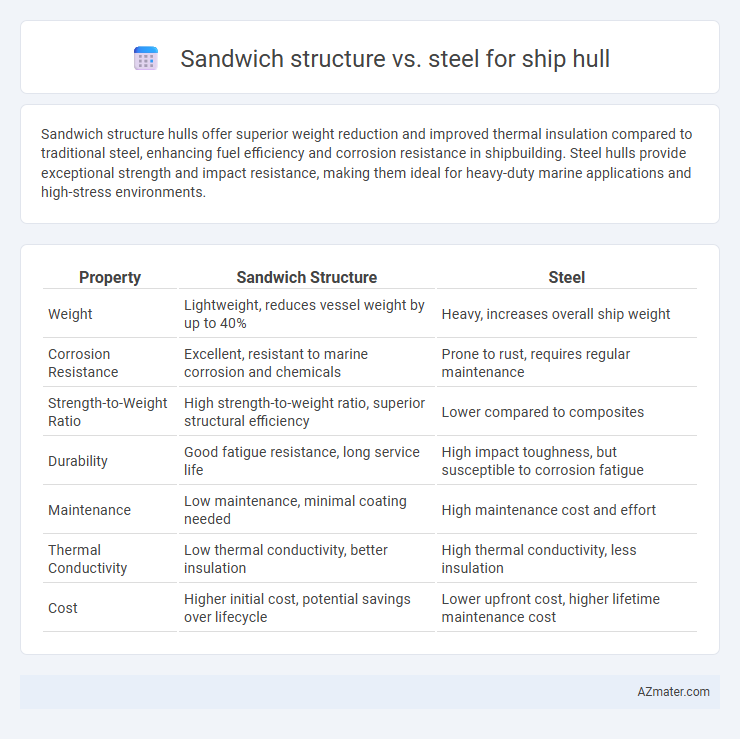Sandwich structure hulls offer superior weight reduction and improved thermal insulation compared to traditional steel, enhancing fuel efficiency and corrosion resistance in shipbuilding. Steel hulls provide exceptional strength and impact resistance, making them ideal for heavy-duty marine applications and high-stress environments.
Table of Comparison
| Property | Sandwich Structure | Steel |
|---|---|---|
| Weight | Lightweight, reduces vessel weight by up to 40% | Heavy, increases overall ship weight |
| Corrosion Resistance | Excellent, resistant to marine corrosion and chemicals | Prone to rust, requires regular maintenance |
| Strength-to-Weight Ratio | High strength-to-weight ratio, superior structural efficiency | Lower compared to composites |
| Durability | Good fatigue resistance, long service life | High impact toughness, but susceptible to corrosion fatigue |
| Maintenance | Low maintenance, minimal coating needed | High maintenance cost and effort |
| Thermal Conductivity | Low thermal conductivity, better insulation | High thermal conductivity, less insulation |
| Cost | Higher initial cost, potential savings over lifecycle | Lower upfront cost, higher lifetime maintenance cost |
Introduction to Ship Hull Materials
Ship hull materials primarily include traditional steel and modern sandwich structures, each offering distinct advantages for maritime applications. Steel provides exceptional strength, durability, and impact resistance, making it a reliable choice for heavy-duty vessels and harsh sea conditions. Sandwich structures combine lightweight composite skins with core materials such as foam or honeycomb, enhancing stiffness and reducing overall weight, which improves fuel efficiency and maneuverability.
Overview of Sandwich Structure Technology
Sandwich structure technology in ship hull construction utilizes composite materials with a lightweight core, such as foam or honeycomb, bonded between two fiber-reinforced polymer (FRP) or metal face sheets. This design offers superior strength-to-weight ratios, enhanced corrosion resistance, and improved thermal insulation compared to traditional steel hulls. The advanced mechanical properties of sandwich composites contribute to increased fuel efficiency and reduced maintenance costs in marine applications.
Properties of Steel in Marine Engineering
Steel in marine engineering offers exceptional tensile strength, corrosion resistance through specialized alloys, and high impact toughness essential for withstanding harsh oceanic conditions. The material provides structural durability and fatigue resistance, ensuring long service life and safety for ship hulls. Its weldability and reparability make steel a preferred choice for complex hull designs and maintenance in maritime environments.
Weight Comparison: Sandwich Structure vs Steel
Sandwich structures for ship hulls significantly reduce overall weight compared to traditional steel, often achieving a weight reduction of up to 40-60%. This lightweight advantage enhances fuel efficiency and vessel speed while maintaining structural integrity through high-strength foam or core materials bonded between composite skins. Steel hulls, while heavier, provide proven durability and impact resistance but contribute to higher displacement and increased fuel consumption.
Strength and Durability Analysis
Sandwich structures, typically composed of a lightweight core material such as foam or honeycomb sandwiched between two composite or metal skins, offer superior strength-to-weight ratios compared to traditional steel hulls, enhancing overall ship performance and fuel efficiency. The core's ability to absorb energy and distribute stress improves impact resistance and durability against deformation under repetitive loading conditions, making sandwich hulls less prone to corrosion and fatigue cracks commonly found in steel. Steel hulls provide excellent long-term durability and structural integrity in harsh marine environments due to their high tensile strength and toughness, but they require more maintenance to prevent corrosion and often result in heavier vessels with reduced speed and increased fuel consumption.
Corrosion Resistance and Maintenance Needs
Sandwich structures, composed of composite materials with core layers, offer superior corrosion resistance compared to traditional steel ship hulls, reducing the need for frequent anti-corrosion treatments. Steel hulls are more susceptible to rust and marine corrosion, requiring regular maintenance, including coating and cathodic protection, to extend service life. This inherent corrosion resistance in sandwich structures translates into lower long-term maintenance costs and improved durability in harsh marine environments.
Cost Implications and Lifecycle Economics
Sandwich structures for ship hulls offer significant cost savings over traditional steel by reducing weight and fuel consumption, leading to lower operational expenses throughout the vessel's lifecycle. Although the initial material and manufacturing costs are typically higher for sandwich composites, their superior corrosion resistance and reduced maintenance demands result in lower repair and downtime expenses. Over the ship's operational lifespan, these factors contribute to a more favorable total cost of ownership compared to conventional steel hulls.
Impact on Fuel Efficiency
Sandwich structure hulls, composed of lightweight composite materials with a core layer, significantly reduce the overall weight of ships compared to traditional steel hulls, leading to improved fuel efficiency through decreased resistance and lower engine power requirements. The reduced weight lowers the vessel's displacement, enabling smoother hull-water interaction and minimizing drag, which directly contributes to lower fuel consumption and operational costs. In contrast, steel hulls, despite their durability and strength, tend to be heavier, resulting in higher fuel usage to maintain comparable speeds and performance.
Safety and Regulatory Considerations
Sandwich structures in ship hulls offer enhanced impact resistance and improved energy absorption compared to traditional steel, contributing to better crew safety during collisions or grounding incidents. Regulatory bodies such as the International Maritime Organization (IMO) increasingly recognize sandwich composites for their fire retardancy and corrosion resistance, aligning with SOLAS (Safety of Life at Sea) standards. Steel remains favored for its predictable performance under extreme conditions and established certification processes, but evolving regulations are encouraging innovation through validated sandwich construction methods.
Future Trends in Ship Hull Construction
Advancements in sandwich structure materials, such as carbon fiber-reinforced polymers combined with foam or honeycomb cores, are driving innovations in ship hull construction by significantly reducing weight and enhancing corrosion resistance compared to traditional steel hulls. Future trends emphasize integrating smart sensors within sandwich panels for real-time structural health monitoring, improving safety and maintenance efficiency. This shift supports sustainable shipbuilding, as lighter hulls allow for lower fuel consumption and reduced greenhouse gas emissions.

Infographic: Sandwich structure vs Steel for Ship hull
 azmater.com
azmater.com